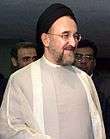Iranian presidential election, 1997
| | |||||||||||||||||||||||
| |||||||||||||||||||||||
| |||||||||||||||||||||||
| |||||||||||||||||||||||
 |
| This article is part of a series on the politics and government of Iran |
|
|
Politics portal |
Iranian presidential election of 1997 took place on 23 May 1997, which resulted in an unpredicted win for the reformist candidate Mohammad Khatami. The election was notable not only for the lopsided majority of the winner - 70% - but for the high turnout. 80% of those eligible to vote did so, compared to 50% in the previous presidential election.[1]
Candidates
The Council of Guardians blocked 234 candidates from running for the presidency because they lacked the religious and political qualifications.[2][3] Only four candidates were permitted to run for office.
- Mohammad Khatami, Former Minister of Culture and Islamic Guidance
- Mohammad Reyshahri, Former Minister of Intelligence and National Security
- Reza Zavarei, Member of Guardian Council
- Ali Akbar Nateq-Nouri, Incumbent Speaker of the Parliament of Iran
Issues
The candidates were asked about their opinion on the fatwa against Salman Rushdie. Ali Akbar Nateq-Nouri said that any "a good Muslim" would carry out the fatwa.[4] Mohammad Khatami avoided the issue.[4] Mohammad Khatami's supporters called Nateq-Nouri the "Taliban" of Iran.[5]
Mohammad Khatami expressed support for the easing Islamic regulations "from women's dress to whether TV satellite dishes should be allowed."[6]
Results
| Party | Candidate | Votes | Percentage | |||
|---|---|---|---|---|---|---|
| Association of Combatant Clerics | Mohammad Khatami | 20,078,187 | 69.6% | |||
| Combatant Clergy Association | Ali Akbar Nategh-Nouri | 7,242,859 | 25.0% | |||
| Independent | Reza Zavarei | 771,460 | 2.7% | |||
| Association for Defence of Revolution Values | Mohammad Reyshahri | 742,598 | 2.6% | |||
| Blank or invalid votes | 240,996 | |||||
| Totals | 29,067,100 | 100.00% | ||||
| Voter turnout | 88% | |||||
| Sources: Ministry of Interior of Iran | ||||||
Aftermath
Khatami's victory began a new era the Islamic Republic, an era of dynamic change to aspects of the existing political climate, and of promise to young Iranians that hope and change could be had under the current system. A spectrum of reformers was identified and drove the belief that fundamental change in national affairs was needed.
Among the objectives of reformers were the reduction of power in the established clerical elite, and the increase of liberty in the constitution; those who supported more radical democratic reforms were sometimes called "fundamentalists"
With a relatively open political atmosphere, new parties were born with astonishing speed. Reformers managed to achieve a majority in the Sixth Parliament (2000). During this period, many newspapers attempted increased freedom in their coverage, resulting in many being closed. Also, for the first time since 1979, students were seen as a potential for driving change.
On Persian date 18 Tir 1378, one of the student movements at Tehran University protested the way newspapers had been treated, but it was declared within a few hours that this small protest was opposed to the Islamic Republic itself.
As time passed, expectations were managed. Reformers rely on three main pillars; the performance of their representatives in Parliament, press freedoms, and a focus on students and education. It had been said that during Khatami's presidency, there was a crisis every 9 days, and reacting to these alone consumed a major amount of time that could have otherwise been focused on reform.
Despite attempts by the Parliament to change the constitution, protesters and those who stood in opposition to the Islamic Republic were still in danger of arrest. Constitutional delegates attempted to grant the right of free speech, but were unable to, and the anger of prosecution remains.
See also
References
- ↑ Abrahamian, Ervand, History of Modern Iran, Columbia University Press, 2008, p.186
- ↑ Calls for reform grow louder as Iran goes to polls 24 May 1997
- ↑ Iran’s Myth of Moderation 18 March 2002
- 1 2 Rushdie key issue in Iran election 22 May 1997
- ↑ Election farce as Iran chooses its president 22 May 1997
- ↑ CNN - Iranians look for economic help from Friday's election - 19 May 1997
External links
| |||||||||||||
| ||||||||||||||||||||||||||||||

.jpg)
